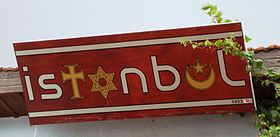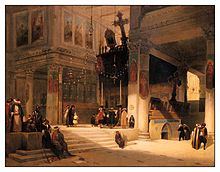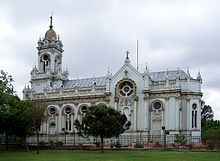Religion in Istanbul
The seat of the Patriarch of Constantinople, spiritual leader of the Eastern Orthodox Church since the 4th century AD, is located in the Fener (Phanar) district.
Despite the absence of a formal institutional structure, Sunni religious functionaries played an important political role.
Justice was dispensed by religious courts; in theory, the codified system of sharia regulated all aspects of life, at least for the Muslim subjects of the empire.
Early in the Ottoman period, the office of grand mufti of Istanbul evolved into that of Sheikh ul-Islam (shaykh, or leader of Islam), which had ultimate jurisdiction over all the courts in the empire and consequently exercised authority over the interpretation and application of sharia.
For this purpose, Mehmed II also founded previously non-existent religious authorities such as the Armenian Patriarchate of Constantinople in 1461.
[9] Into the 19th century, the Christians of Istanbul tended to be either Greek Orthodox, members of the Armenian Apostolic Church or Catholic Levantines.
[10] The everyday life of the Christians (50%), particularly the Greeks (260,000) and Armenians (160,000), living in Istanbul changed significantly following the bitter conflicts between these ethnic groups and the Turks during the Decline of the Ottoman Empire, which began in the 1820s and continued for a century.
The city's Greek Orthodox community was exempted from the population exchange between Greece and Turkey in 1923 following the establishment of the Turkish Republic.
[14] Beside the mostly Catholic Levantines, who are the descendants of European (Genoese, Venetian and French) traders who established trading outposts during the Byzantine and Ottoman periods, there is also a small, scattered number of Bosphorus Germans.
Garibaldi lived in Beyoğlu and taught Italian, French and Mathematics in the foreign schools of this district.
[15] The Società Operaia Italiana di Mutuo Soccorso is still active and is located in its original site, on a side street of İstiklal Avenue.
The Varlık Vergisi (Wealth Tax) of the World War II years, which imposed higher tariffs on non-Muslims and foreigners in Turkey, also played an important role in the migration of Istanbul's Italians to Italy—who still live in the city, but in far fewer numbers when compared with the early 20th century.
The influence of the Italian community of Istanbul, however, is still visible in the architecture of many quarters, particularly Galata, Beyoğlu and Nişantaşı.
The Sephardic Jews contributed much to the rising power of the Ottoman Empire by introducing new ideas, methods and craftsmanship.
The first Gutenberg press in Istanbul was established by the Sephardic Jews in 1493, who excelled in many areas, particularly medicine, trade and banking.







